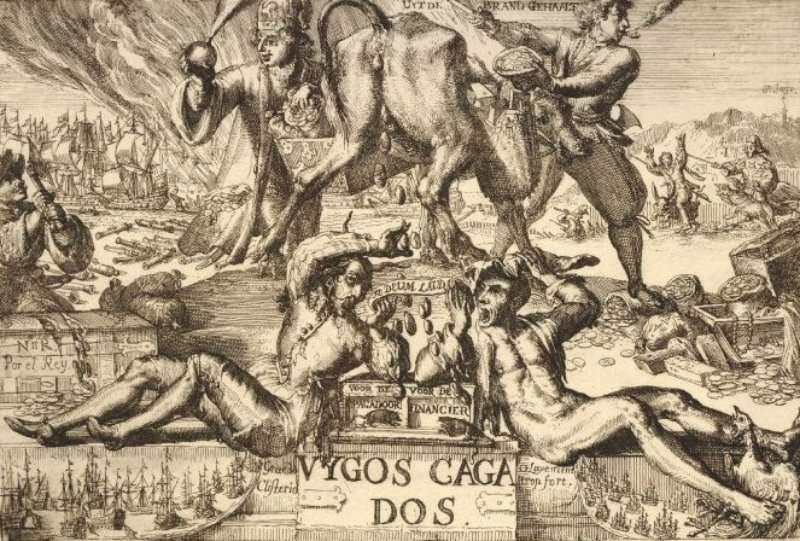Where the English poem unaccountably failed to mention the Dutch contribution, the Dutch credit themselves with the victory but at least mention their allies in this tremendous multilingual sketch. The curator seems to have enjoyed himself:
Dutch broadside satirising the Spanish and French after the victory of the British and Dutch fleet at the Battle of Vigo Bay with an etching showing an ox loaded with treasure defecating onto a Spaniard and a Frenchman. The Spaniard has just received a “Grande Clisterio” and the, almost naked, Frenchman a “Lavement trop fort” and each defecates a fleet of ships; at the Frenchman’s feet is a distressed cock. The men, proclaiming “Te Deum Laudamus”, rest on a treasure chest on which the title of the print is lettered, and on top of which are two smaller boxes which rats are attacking; they are labelled “voor de pagador” and “voor de financier”. To the left of the ox stands Louis XIV holding a hand-grenade and a bag of coins, more coins spilling from his pocket; he wears a grenadier’s cap to which is attached a fool’s bell. To the right, the ox’s head is held by a sailor smoking a pipe and holding a bag of money. On the left of the scene, another sailor breaks open another chest from which money spills; it is lettered “N R/Por el Rey”; on the right, further chests and bags of money. In the background, on the left, a sea battle rages; on the right, Philip V of Spain mounted on a hare, is chased by Charles of Austria mounted on an eagle; behind them is the town of Santiago de Compostela. Engraved title and inscriptions, and with letterpress title and verses in two columns. (n.p.: [1702])
Unfortunately the Man from the Museum doesn’t seem to have understood the title and hence the laxative by which Spain and France are purged: “Vygos Cagados” is a pun on figo and what for the Dutch is its homophone, Vigo, and the ox, or perhaps donkey (fore- and hindquarters don’t agree), is shitting figs.
Problems:
- Buccalisation of the Latin labiodental F (fīcu) may have taken place in Iberia around a thousand years previously, and by the time of the War of the Spanish Succession the only figo written in standard Spanish was that belonging to the surname and toponym Figueras.
- Figo was the spelling used for fig until the end of the 15th century, when the spelling of standard Spanish changed to reflect phonological reality and higo came to be written as well as spoken.
So
- how did the pun occur to our anonymous Low Countries author, and
- who did he think it would amuse?
The answer to the first question is obviously that the Iberian soldiers and sailors with whom Dutch-speakers came into contact didn’t speak 100% standard Spanish – unsurprisingly, since many came from the coasts, where Spanish did not dominate popular speech as it does today. In Portuguese (and presumably Galician) fig is figo (the Dutch is f- f- f- vijg), and anglesos in the following splendid snatch of dialogue is a Catalanism:
“Ay pisselingros, ay anglesos, picoros naturales,
Dénos flottas, galliones pesos y reales!”
“Calle la boca, cabrón,” [I cried]
The answer to the second question is presumably that the great ports of the Low Countries contained sufficient literates with money to spare, reasonably filthy minds, and at least basic multilingual skills (Ah! Spanish Antwerp!) to justify publications like this. And it is to them that the clumsy tranliteration pisselingro is directed: whatever the etymology of pechelingue/pichinglis/etc, Spanish sailors must have used the term to indicate and insult speakers of a silly coastal dialect with still enough global ambitions to ransack God’s own treasure fleet in its home port.
Similar posts
Back soon


Etymologically, Vigo has abs. nothing to do with ficu. It comes from vicus. The pun might refer to “figo/figa” = cunt.